Check it out here:
https://www.kickstarter.com/projects/sienci/sienci-mill-one-simple-and-affordable-desktop-cnc/
Check it out here:
https://www.kickstarter.com/projects/sienci/sienci-mill-one-simple-and-affordable-desktop-cnc/
AS FEATURED ON 3DPC.co
http://3dpc.co/meet-3d-printings-big-brother-cnc-milling-3442/
While CNC milling machines come in all shapes and sizes, there is one thing they all have in common: computer numerical control. Yes, CNC stands for computer numerical control. These machines implement mechanical and electrical systems to control a milling tool in three dimensional space. Unlike a 3D printer, which is a “additive†manufacturing process that involves stacking layers and layers of plastic, CNC milling is a “subtractive manufacturing process that starts from a base material and carves away at it until you are left with a finalized part.
These machines are used to manufacture everything from the furniture you’re sitting on to the injection molding forms that make up a huge number of the things you use every day. And since they can shape virtually any material, the applications are endless.
3D printing has gone from expensive industrial machines to affordable consumer machines that fit on your desktop. So why hasn’t the same happened with CNC milling machines?
Well, there are a few challenges in creating a device suitable for your home, but the biggest challenge has been creating the necessary mechanics to stand the enormous forces CNC machines need to handle. The robust linear motion systems needed to control these machines are expensive and complicated, and that shows on the price tag for current desktop CNC milling machines.
Sienci Labs, a group based in Waterloo, ON, have developed low cost, high performance linear motion systems to finally create the machines that you can afford to put on your desktop. And with partnerships with some of the most innovative CAM and CAD developers, they’ve created the fastest and easiest user experience in desktop CNC milling.
The Sienci Mill One is a $399 desktop CNC milling machine that creates 2D and 3D models from materials like wood, plastic, brass, aluminum, and foam.
Working area: 250mm x 200mm x 100mm
Working materials: Wood, foam, aluminum, brass, leather, PVC, acrylic, ABS, PCB boards, and more
Precision: The Sienci Mill One comes with anti backlash leadscrews with a thread pitch of 2mm/revolution, as well as stepper motors with a resolution of 200 steps/revolution. The Sienci Mill One can accurately reproduce details within 0.001″.
Speeds: Recommended speeds are between 250mm/min to 1500mm/min
Firmware: GRBL
While the Sienci Mill One can handle gcode generated by virtually all modern CAM software, we’ve partnered with Onshape to bring fun, fast, and free CAM and CAD programs to help you draw 3D models and create the code that controls the Sienci Mill One.
With CAM programs like Kiri:Moto, both beginner and advanced users can create gcode on their browser in mere minutes.
Try it out at www.onshape.com
Sienci Labs is sold out of their first batch of machines and will be starting a Kickstarter in the middle of August!
Prices for the Kickstarter are:
$399: Sienci Mill One Kit*
$549: Sienci Mill One Assembled*
$139: 1-¼ HP Router Kit
*does not come with router
Sign up for the mailing list at:
https://sienci.com/kickstarter/
Over the last couple of weeks, Chris and I have been working hard on building the machines for our first set of orders. We decided to try putting together a few kits so that we would know what steps we would need to take to put them together for our Kickstarter. This also helps us figure out the lead times and what sort of quality our suppliers can provide.
Parts from Shenzhen:
We received our parts from Shenzhen  through a supplier that manufactures 3D printer and CNC parts. We ordered a small number stepper motors, eccentric nuts, and Delrin V wheels through this supplier, and they were kind enough to take our small order and ship it to us through Express Shipping. Even with a 3 day delay after Typhoon Nida slamming the area and people unable to go to work, we got our shipment on time for our first set of deliveries.
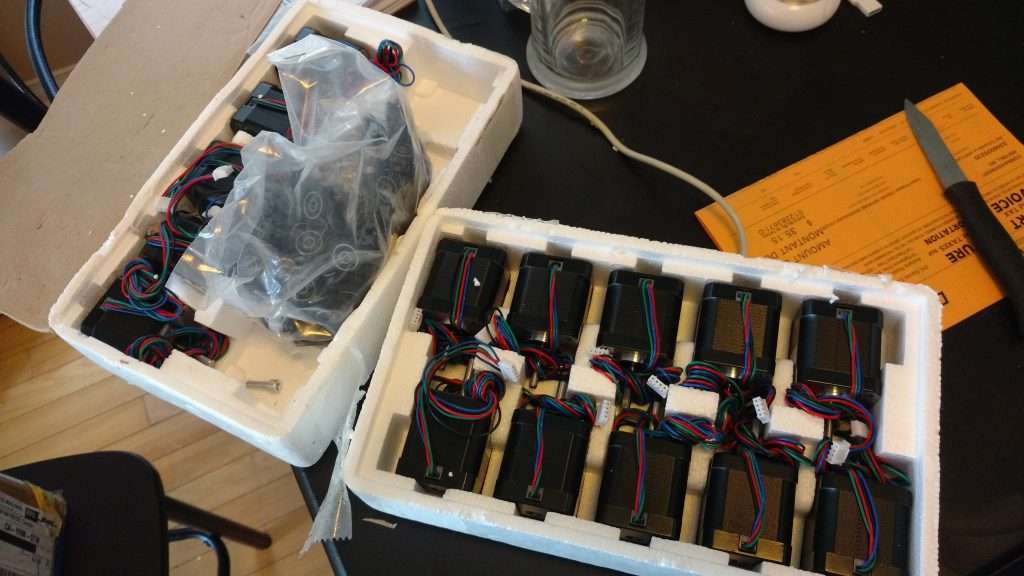
Assembly:
Since last week I have brought the kits to two companies in Ontario. There were a couple of hitches but after ironing them out, things went fairly smoothly.
At the first session I found that the M3 screws that hold the NEMA 17 motors to the angle mounts were slightly too long… 2mm too long in fact. This was causing the screws at the other end of the motor to start turning out, and I had to go find the proper screws for the machine. I also discovered that we would need to tolerance the through holes wider to make assembly easier. We didn’t get to complete the assembly of the machine that day, but since then I’ve found the correct screws and will be going back this week to finish up the build.
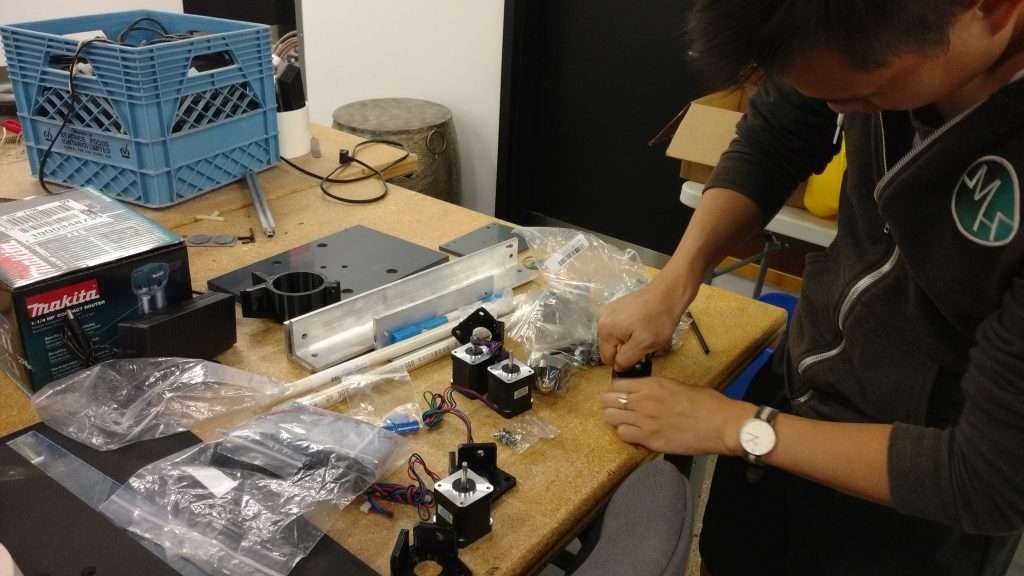
At the second session with another company, I found that the second issue was that the the front shield of the machine offered too snug of a fit. Luckily I had a shield that was slightly thinner, and was able to replace and complete the assembly. After I left, the customer discovered that without the bed being completely level, the machine had issues cutting out materials from a blank stock. Under typical use, this small discrepancy would not make a difference, but in applications like PCB milling or cutting very thin materials, even cuts can be critical. I am working on this with the customer to provide the documentation needed to level the bed, or issue a refund if things cannot be resolved.
Final thoughts:
I can’t say these past experiences were completely smooth sailing, but with what I learned from these assembly sessions, we know what to watch out for when start mass manufacturing these machines. As Paul Graham  states in his essay “Do Things That Don’t Scale”, this initial step of getting out and putting our machine in an uncontrolled environment is a important step for us to learn what it will be like when we do scale.
We shot our Kickstarter video yesterday! We hired one of our buddies from Enterprise Co-op who’s starting his own video production company to make our video for us.
We started at 12, right after my mentoring session at the Waterloo City Hall. It was a long day of filming, working until 9:30pm to finally get all the footage we needed. Our video should be done and released on Monday! Make sure to stay tuned to see our masterpiece.
Check out Terence’s work at https://www.youtube.com/user/ITerenceI

Going from a drawing on your computer to a real object in your hand can be a difficult process. While tools like laser cutters and 3D printers have come down in price and have gone up in ease of use, CNC milling has been one of the more challenging machines to put on a desktop.
While the fact that you can get production quality parts from virtually any material may be an awesome feature to have for engineering firms and small businesses, the need for incredibly robust mechanics and complicated set-up and programming procedures has made desktop CNCing a late bloomer in the low cost rapid prototyping industry. With the emergence of low cost machines like the Shapeoko and the X Carve, Nomad and Carvey, as well as the newly developed Sienci Mill One, it’s easier than ever to put a CNC machine on your desktop.
Our team at Sienci Labs brought the Sienci Mill One to Communitech to run a workshop with one our our clients, Medella Health, to show how their hardware engineers could take their designs and ideas and produce them using the machine. Medella Health develops next generation biosensors and electronics, to monitor our health and change the way we take care of ourselves.
With programs like Onshape and Kiri:Moto, we were able to create teflon flow cell sensors that retail for thousand dollars each, and create prototypes that would take weeks to fabricate and cost thousands of dollars through out-of-house firms. With deskop CNC machines like the Sienci Mil One, companies like Medella Health can create a wide number of things at a fraction of the cost and time. Not only that, Onshape’s easy to use interface makes learning the software simple for both seasoned CAD warriors and brand new users, so that companies can get their engineers onto the platform painlessly.
We’re excited to be on the forefront of changing the way we turn digital designs into real physical objects, and technologies like browser based CAD and CAM, as well as low cost rapid prototyping tools will change the way we create.
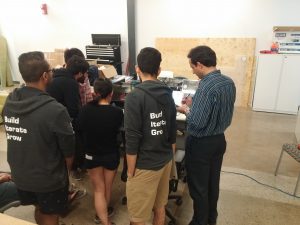
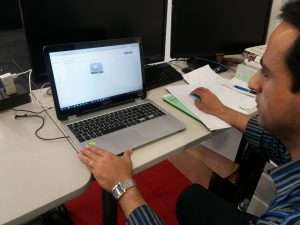
During the past 5 weeks, Sienci Labs took on two first year students as part of the BETS (Bridging Entrepreneurs to Students) program. One of our students, Ria, wrote about her 5 week experience:
Working at Sienci Labs for the past 5 weeks has been such an adventure. As a co-op student, I got to take on a variety of tasks for which I had the minimal skill set required and develop these skills while working in a great start-up environment, designing a product that will essentially make our customers’ lives easier; a win-win situation!
One of the most rewarding things about working at Sienci Labs was I found myself working with a team that is passionate and enthusiastic about the work they do. Being part of the entrepreneurial team taught me various ways to innovate. Andy would constantly be identifying a problem with the prototype and would need to find a new efficient way to solve it and this process taught me how to be an ingenious engineer. I was in charge of a lot of the testing for the software that would be used to make our users’ experience easier, despite of their technical backgrounds so it was nice to have a job where I knew my work would directly affect the user experience.
The effort he put into creating a sustainable machine was evident and the product’s transformation over the past 5 weeks has been phenomenal. Can’t wait to see where the team takes the company in the future!
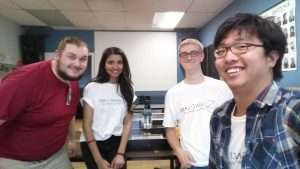
(Ria is the girl in the middle)
It has been a really intense few weeks and I have not had the time to post anything new.
I have made a few new updates on the design that improve the performance of the machine.
During the past week or so, we have done a few cool things as well.
We got a chance to tour Tiercel Technology, who contacted us to help us with designing our machine to be manufactured. They were awesome and gave us a lot of ideas to improve our design.
We also went to the Kitchener Market to show off our machine and sell some of the things we milled to prove that artists can mill things with our machine and to make money. We weren’t there to make money, but we sold a few things and made $22.
At the Market, we also met Grant Greenfield from the KW Woodworking and Craft Centre. He showed me around this week and gave me a box of walnut wood to mill! He’s a great fellow.
We received an extra $1600 in funding from the University today in the mail. We are still waiting on $2500 to come in from the Engineer of the Future Trust.
At this current moment, we have 2 of our 5 pre-production models claimed. Order yours now to get your hands on the first batch of machines. If you can wait, stay tuned for our Kickstarter!
It is late now and I must go sleep. Thank you for your support! Goodnight everyone!
Thank you for everyone who came out to Maker Festival to support us and the greater maker community! It’s exciting to see amazing projects like stair climbing robots, hyper fast bikes, and leather origami.
It was great to get so much interest, feedback, and ideas. For everyone who have asked to place orders, we will be getting in touch with you soon!
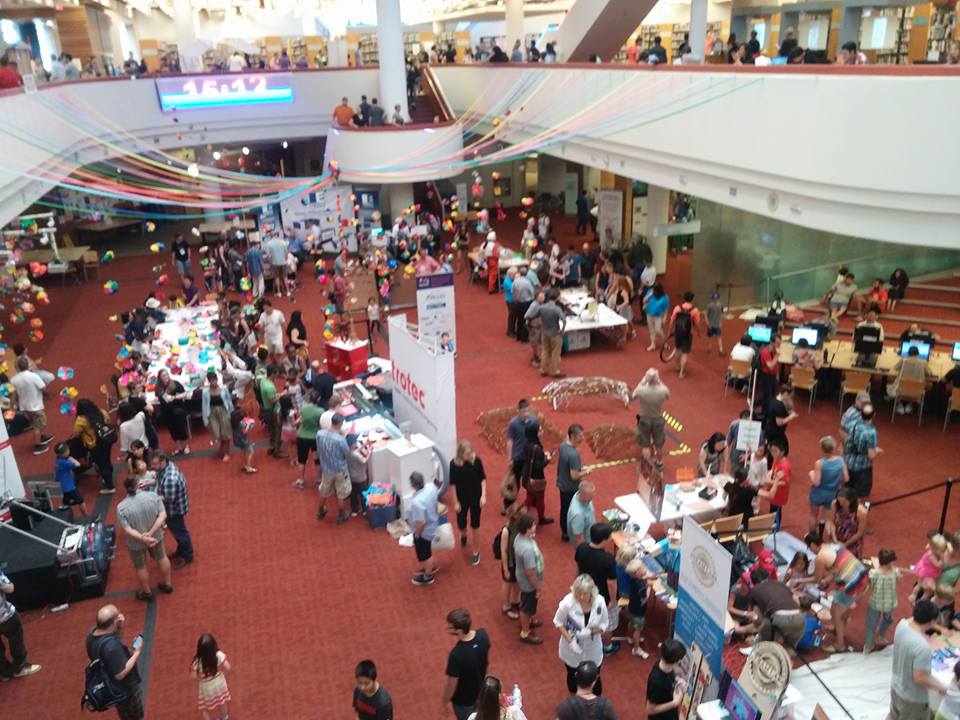
No rapid prototyping tool is complete without an awesome software package! We’re happy to let you guys know that we will be working with Onshape to provide you with easy to use and powerful programs that will help you create 3D models and control the Sienci Mill.
Onshape is the first and only full-cloud 3D CAD system that lets everyone on a design team work together using any web browser, phone, or tablet.
Onshape was built from scratch for the way today’s engineers, designers and manufacturers really work, giving them secure and simultaneous access to a single master version of their CAD data without the hassles of software licenses or copying files.
How do we know Onshape is easy to use? We’ve had people with no previous CAM experience create gcode and get milling using our machine in only a few minutes through an addon app called Kiri:Moto.
After trying out the program and loving it, we reached out and got in contact with Joe Dunne and worked on creating a strategic partnership. He is super awesome.
Check out Onshape here: www.onshape.com
and Kiri:Moto here:Â grid.space/kiri